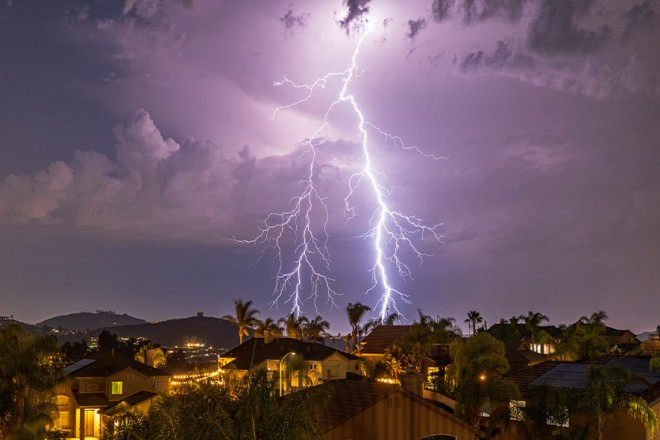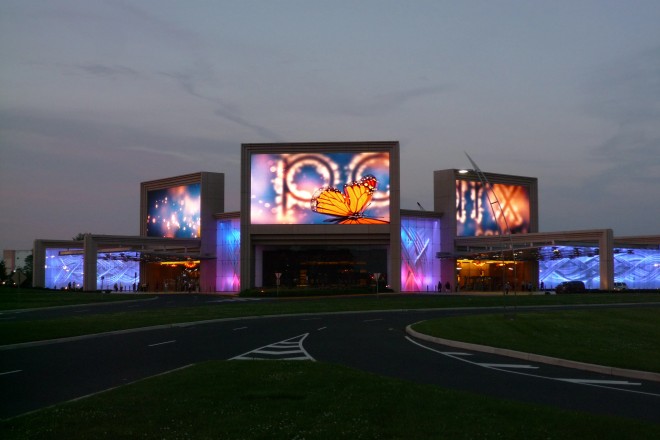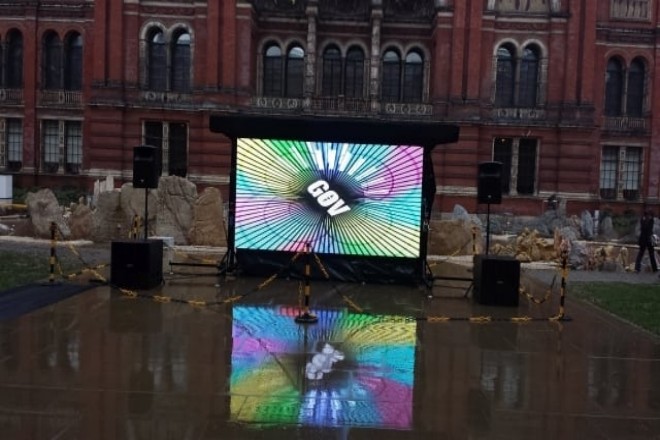介绍

作为现代城市的重要组成部分, 户外LED显示屏 不仅美化了城市景观,而且高效地传递信息。
但在雷雨天气多发地区,这些显示屏面临着严重的雷电灾害威胁。
因此探索并实施有效的防护措施,保证雷雨季节户外LED显示屏的安全运行显得尤为重要。
1、户外LED显示屏防直击雷的防护
在防直击雷方面,安装避雷针是至关重要的环节,下面就避雷针的选用、规格、安装位置选择原则进行详细介绍:
1).避雷针的种类及规格:
避雷针的种类很多,有单针避雷针、防雷网系统等,具体选用应根据被保护对象的特点(如高度、功能、周围环境等)决定。
在规格方面,应保证避雷针能承受预期的雷电流冲击,并具有良好的导电性能。
2).安装位置的选择原则:
- 最高点安装原则:
避雷针或设备应安装在建筑物的最高处,保证其能吸引雷电,并避免其他未受保护区域遭受雷击。
一般情况下,避雷针的安装高度应高出被保护物最高点3~5米。
- 保护范围计算:
避雷针的保护范围可采用折线法和滚球法计算,根据建筑物的高度和避雷针的安装高度,合理计算其保护半径,确保完全覆盖被保护的建筑物或设备。
- 多级保护:
对于复杂的建筑物,例如高层建筑、塔楼或工业设施,单个避雷针可能无法提供全面的保护。
此时需要根据建筑物的高度、结构等设计多层次、多点的防雷系统,安装多根避雷针和引下线系统。
3).安装要求:
避雷针必须与引下线紧密连接,而引下线应采用导电性能良好的材料,如铜或铝,以保证雷电流能迅速、安全地引入地下。
引下线应尽量布置成直线,减少急转弯和拐角,以减少雷电流在流动过程中因弯曲处电阻增加而引起的电弧放电。
避雷针的支撑结构必须稳定可靠,特别是在高层建筑或杆塔上安装避雷针时,必须保证其稳定性和抗风性。
避雷针的接地是将其雷电流引导入地的关键环节,而接地系统的设计决定了防雷装置的有效性。接地电阻应尽可能低,以保证雷电流能顺利泄入地下。
2、户外LED显示屏钢结构需要做哪些防护措施

1).等电位连接:手拉手,人人平安
想象一下,当闪电击中户外LED显示屏附近的地面或建筑物时,它会找到一条路径来释放能量。
如果钢结构和显示屏外壳之间存在电位差,雷电可能会通过这种电位差造成损坏。为了避免这种情况,我们需要将钢结构和显示屏外壳“手拉手”连接起来,使它们处于相同的电位水平。
具体操作是利用导电材料(如铜带或铜线)将钢结构各部分与显示屏外壳连接起来。
这样,当雷电袭来时,钢结构和显示屏外壳都会以相同的电位迎接雷电,从而减少因电位差带来的损害。
2). 接地:给雷电一个良好的去处
接地是保证雷电能安全释放到地下的关键步骤。试想一下,如果雷电在钢结构上找到了“出口”,但不能顺利进入地下,那么雷电就会四处逃窜,对周围的设备造成损害。
为了保证雷电能够顺利泄放,我们需要:
- 测量接地电阻:
使用专业接地电阻测试仪测量当前接地系统的电阻,理想情况下该电阻应小于10欧姆,如果电阻太大,雷电无法顺利泄放。
- 添加人工接地网络:
如果自然接地体的电阻达不到要求,可以考虑增设人工接地网,这通常是将一系列导电材料(如角钢、扁钢等)埋入地下,并连接起来形成网络,这个网络可以为雷电提供一个更好的“出口”。
- 避雷器的接地:
避雷器是专门用来保护设备免受雷击的装置,为了保证设备的正常工作,我们需要将避雷器也接地,这样当雷电击中显示屏时,避雷器可以迅速将雷电引导到地下,从而保护显示屏不受损坏。
3). 其他防护措施:全方位防护
除了等电位连接和接地处理外,还需考虑以下防护措施:
- 防腐处理:
室外环境复杂多变,钢结构容易受到腐蚀,因此我们需要对钢结构表面进行防腐处理,比如喷防腐漆或者热镀锌。
这可以延长钢结构的使用寿命,减少因腐蚀引起的安全隐患。
- 定期检查和维护:
定期对钢结构进行检查和保养非常重要,需要检查钢结构各连接处是否严密,防腐层是否完好,如果发现问题需要及时处理,确保钢结构的稳定和安全。
- 考虑环境因素:
在钢结构设计安装时,需要充分考虑室外环境因素的影响。比如,在风力较大的地区,需要增加钢结构的抗风性能;在降雨较多的地区,需要保证钢结构具有良好的排水、防水性能。
3、户外LED显示屏电源线、信号线需要做哪些保护措施?
户外LED显示屏的电源线、信号线在雷电等恶劣天气条件下,极易遭受雷击损坏,因此需要采取一系列的防护措施,保证它们的安全运行。
下面就电源线、信号线所需采取的保护措施进行详细说明:
1).电源线保护措施
- 安装电源避雷器:
在电源线上安装单相或者三相电源避雷器,可以有效防止雷电通过电源线损坏LED显示屏。
电源避雷器应选用质量可靠、性能稳定的产品,并保证其能承受预期的雷电流冲击。
安装电源防雷器时,必须保证相线、地线的截面积符合要求,以保证防雷器正常工作。
- 定期检查和维护:
定期对电源线进行检查和保养,保证电源线连接紧固可靠,无损坏、老化。
如果电源线有问题,应及时更换或者修理,避免因电源线故障导致显示屏损坏。
2).信号线路保护措施
- 安装信号避雷器:
根据信号接口类型(如网线、串口等),安装相应的信号防雷器,保护信号系统免受雷击破坏。
信号防雷器应选用与信号系统相匹配的型号和规格,并确保其具有良好的防雷性能。
安装信号防雷器时,需要保证地线截面积足够大,以减少雷电对信号线路的影响。
- 屏蔽和接地:
信号线应采用屏蔽电缆,以减少雷电等外界干扰对信号传输的影响。
屏蔽电缆的屏蔽层应良好接地,以保证屏蔽效果。
- 定期检查和维护:
定期对信号线进行检查和维护,保证信号线连接紧密可靠,无损坏、老化。
若信号线出现问题应及时更换或者修复,避免因信号线故障造成显示屏显示异常或者通讯失败。
4、户外LED显示屏防雷击的其他防护措施

1).散热设计:让显示屏“降温”。
1.1).为什么要散热?
LED显示屏在工作时会产生热量,特别是长时间高亮度运行时,如果热量不能及时散发,会导致显示屏内部温度升高,不仅影响显示效果,还有可能缩短显示屏的使用寿命。
1.2).如何散热?
外壳设计:显示器的外壳可以设计成空心的,也可以设计有散热孔,这样空气可以流通,有助于散热。
增加散热设备:在显示器内部或附近安装风扇、空调等散热设备,这些设备可以通过吹风或冷却的方式帮助显示器快速降温。
选择散热材料:在显示器制造过程中,可以选择导热性好的材料,例如铝合金等,以便更有效地传导热量。
2).防潮措施:保持显示屏远离潮湿
2.1).为什么要防潮?
潮湿的环境会导致显示器内部的电子元器件受潮,影响显示器的正常工作,如果显示器长期处于潮湿的环境中,可能会出现故障甚至损坏。
2.2).如何防潮?
规律使用:在雨季,规律使用显示屏可帮助其内部升温,减少湿气的影响。建议每周至少使用一次,每次点亮2小时以上。
外壳密封性:显示屏外壳应做好防水、防潮设计,在制造过程中可使用密封胶、防水垫等材料来增强外壳的密封性。
干燥剂:在显示屏内部或者附近放置干燥剂,可以吸收空气中的水分,降低湿度。
3).结构检测:保证显示屏的稳定性
3.1).为什么要检查结构?
显示屏的结构稳定性对其正常运行至关重要,如果结构松动或者损坏,可能造成显示屏倾斜、掉落等安全隐患。
3.2).如何检查?
定期检查:定期检查显示屏的吊挂点、支撑结构等,确保其牢固可靠,可用螺丝刀、扳手等工具进行紧固。
加固处理:若发现松动、损坏等情况,应及时进行加固处理,可采用附加支架、螺栓等方式,增强结构的稳定性。
4).环境管理:保护显示屏不受外界因素的损坏
4.1).为什么需要环境管理?
户外LED显示屏 暴露在自然环境中,容易受到各种外界因素的影响,如昆虫叮咬、紫外线等,这些因素可能会导致显示屏发生故障或损坏。
4.2).如何管理?
防虫咬:定期检查显示屏周边,清理杂物垃圾,防止昆虫栖息。可使用灭鼠药、杀虫剂等,防止昆虫叮咬。
防晒:避免显示屏长时间暴露在阳光下,可用遮阳伞、阳伞等遮挡阳光,同时选用防紫外线性能好的材料制作显示屏外壳和屏幕。
5).电源检查:确保供电系统安全、稳定
5.1).为什么要检查电源?
电源是显示屏正常工作的基础,如果供电系统出现故障或者不稳定,都可能导致显示屏无法正常工作,甚至损坏。
5.2).如何检查?
接地检查:确保接地插座安装正确,接地电阻符合要求,可用接地电阻测试仪检测接地电阻值。同时应避免零线、火线连接错误,确保电源线连接正确。
电源保养:经常断电时,应认真检查电源线及供电设备,检查电源线有无破损、老化、松动等现象,同时定期清理供电设备内部的灰尘、杂物,保持清洁、散热良好。
备份 电源:若有条件,可配备备用电源设备,当主电源发生故障时,可切换到备用电源,保证显示屏的正常工作。
结论
综上所述,对于雷电多发地区的户外LED显示屏,通过全面的防雷、优化散热、加强安全控制等措施,可以有效提高其稳定性和安全性。
这需要我们持续关注、科学应对,不断优化防护技术和方法。
同时用户也应提高安全意识,合理使用、保养显示屏,让我们共同守护城市之光,为城市现代化建设贡献力量。
最后,如果你想了解更多关于LED显示屏的信息, 请与我们联系。
